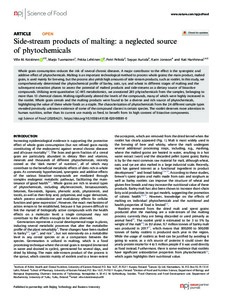Side-stream products of malting: a neglected source of phytochemicals
Koistinen VM; Lehtinen P; Jonsson K; Auriola S; Hanhineva K; Tuomainen M; Peltola P
Side-stream products of malting: a neglected source of phytochemicals
Koistinen VM
Lehtinen P
Jonsson K
Auriola S
Hanhineva K
Tuomainen M
Peltola P
Springer Nature
Julkaisun pysyvä osoite on:
https://urn.fi/URN:NBN:fi-fe2021042827348
https://urn.fi/URN:NBN:fi-fe2021042827348
Tiivistelmä
Whole grain consumption reduces the risk of several chronic diseases. A major contributor to the effect is the synergistic and additive effect of phytochemicals. Malting is an important technological method to process whole grains; the main product, malted grain, is used mainly for brewing, but the process also yields high amounts of side-stream products, such as rootlet. In this study, we comprehensively determined the phytochemical profile of barley, oats, rye, and wheat in different stages of malting and the subsequent extraction phases to assess the potential of malted products and side-streams as a dietary source of bioactive compounds. Utilizing semi-quantitative LC-MS metabolomics, we annotated 285 phytochemicals from the samples, belonging to more than 13 chemical classes. Malting significantly altered the levels of the compounds, many of which were highly increased in the rootlet. Whole grain cereals and the malting products were found to be a diverse and rich source of phytochemicals, highlighting the value of these whole foods as a staple. The characterization of phytochemicals from the 24 different sample types revealed previously unknown existence of some of the compound classes in certain species. The rootlet deserves more attention in human nutrition, rather than its current use mainly as feed, to benefit from its high content of bioactive components.
Kokoelmat
- Rinnakkaistallenteet [27094]
